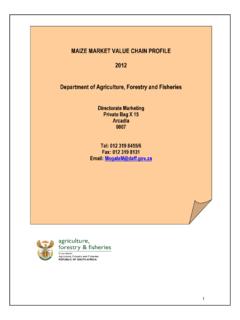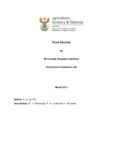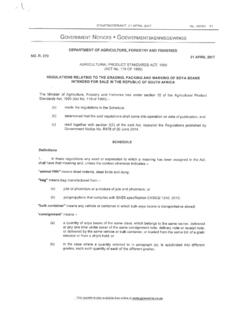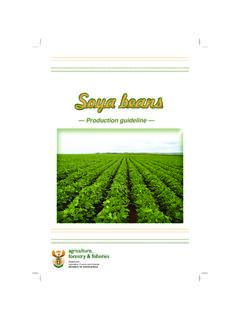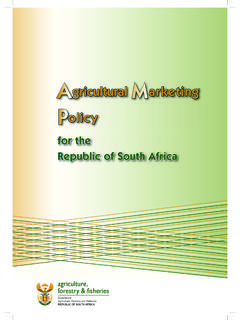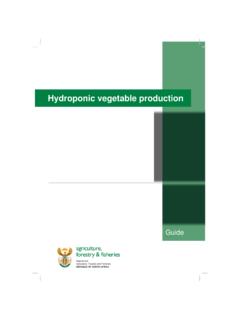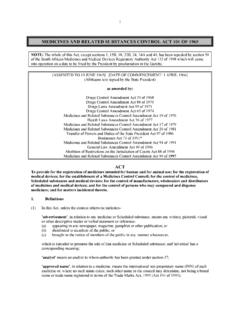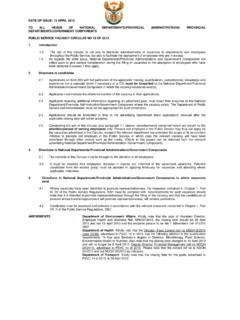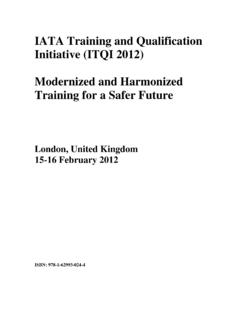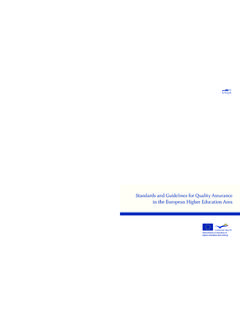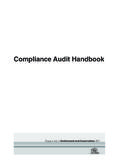Transcription of Step-by-step Export Manual for Step-by-step export manual ...
1 Step-by-step Export Manual for ExportErs of Step-by-step Export Manual south AfricAn for procEssEd exporters fruits, of South African VEgEtAblEs processed fruits,And nuts and nuts vegetables January January 2014. 2014. Department of Agriculture, Department of Agriculture, Forestry and Fisheries Forestry and Fisheries (DAFF). Republic of South Africa Republic of South Africa agriculture, forestry & fisheries Department: Agriculture, Forestry and Fisheries REPUBLIC OF SOUTH AFRICA. Step-by-step Export Manual Published by for Directorate international Trade exporters of South African Department of Agriculture, Forestry and Fisheries processed fruits, vegetables and nuts January 2014. ISBN: 978-1-86871-385-1. Copyright 2014. All rights reserved. Department of Agriculture, Forestry and Fisheries Department of Agriculture, Forestry and Fisheries Directorate international Trade Private Bag X250.
2 0001 Pretoria This document has been compiled by The Department of E-mail: Agriculture, Forestry and Fisheries and every effort has been made to ensure the accuracy of the information contained herein. The Department cannot, however, be held responsible for any errors, omissions or inaccuracies in such information and data, whether inadvertent or otherwise. The Department of Agriculture, Forestry and Fisheries, therefore, accepts no liability that can be incurred resulting from the use of this information. No parts of this document may be reproduced without the permission of the copyright holder. CONTENTS. Acronyms and abbreviations II. Introduction 1. Chapter 1: Overview of the Export process and procedure 3. Chapter 2: DAFF registration and regulations 5. Chapter 3: Traceability, packaging, labelling and packing 7.
3 Contents Chapter 4: Hazard analysis and critical control points (HACCP) 10. Chapter 5: Food standards required in foreign markets 13. Chapter 6: Registration as an exporter with the South African Revenue Service (SARS) 16. Chapter 7: Documentary requirements for exporting processed fruits, vegetables and nuts 18. Chapter 8: Delivery terms (Incoterms ) and international transport modes 21. Chapter 9: Cost breakdown of shipments 25. Chapter 10: Where to find help (guidance, training , coaching) 29. Chapter 11: Financial support for exporters 33. Chapter 12: Export readiness checklist 37. Chapter 13: Information sources for Export market research 40. Appendix 1: Packaging checklist for exporters of food products 43. Acknowledgements 46. I. ACRONYMS AND ABBREVIATIONS. AGOA Africa Growth and Opportunity Act ARC Agricultural Research Council BAF Bunker adjustment factor BFAP Bureau for Food and Agricultural Policy BRC British Retail Consortium CAF Currency adjustment factor CBI Centre for the Promotion of Imports from Developing Countries CCP Critical control points CFR Cost and freight CIF Cost, insurance and freight CIP Carriage and insurance paid to CPT Carriage paid to ACRONYMS AND DAFF Department of Agriculture.
4 Forestry and Fisheries ABBREVIATIONS DAP DAT Delivered at place Delivered at terminal DDP Delivered duty paid DFTS Dried Fruit Technical Services DoH Department of Health EAN European Article Number EFTA European Free Trade Area EMIA Export Marketing & Investment Assistance EU European Union EXW Ex works FAS Free alongside ship FBO Food Business Operator FCA Free carrier FCL Full container load FDA Food & Drug Administration in the USA. FDI Foreign Direct Investment FLT Full liner terms FOB Free on board II. ACRONYMS AND ABBREVIATIONS. GSP Generalised System of Preferences HACCP Hazard Analysis and Critical Control Points HS Harmonised System. iata international Air transport association ICC international Chamber of Commerce IDC Industrial Development Corporation IPPC international Plant Protection Convention ISO international Standards Organisation ISPM 15 international Standard on Phytosanitary Measures ISPS international Security Port Surcharge JETRO Japanese External Trade Organisation LCL Less than a full container load MRA Mutual recognition agreement NEF National Employment Fund NPPO National Plant Protection Organisation PMR Primary Market Research PPECB Perishable Products Export Control Board SABS South African Bureau of Standards SACU Southern African Customs Union SADC Southern Africa Development Community SAFJA South African Fruit Juice association SAFVCA South African Fruit and Vegetable Canners
5 association SAFVCEC South African Fruit and Vegetable Canners Export Council SAMAC South African Macadamia Growers association SANAS South African National Accreditation System SARS South African Revenue Service SEDA Small Enterprise Development Agency SEFA Small Enterprise Finance Agency SGS Soci t G n rale de Surveillance TDCA Trade, Development and Co-operation Agreement The dti Department of Trade and Industry TISA Trade & Investment South Africa UPC Universal Product Code USDA United States Department of Agriculture VAT Value added tax WHO World Health Organisation III. INTRODUCTION. Why have we produced this Manual ? Producers of processed fruits, vegetables and nuts frequently approach DAFF's Directorate: international Trade for information regarding the Export of their products to foreign markets.
6 Producers and traders are anxious to know how to Export , where they can Export to and where to find details about the requirements and INTRODUCTION standards of various importing countries around the world. This Manual aims to provide the answer to most of these questions and to guide potential exporters towards more detailed information regarding the Export of processed (canned/dried/frozen) fruits, vegetables and nuts. HOW TO USE THIS Manual . This Manual should be used as a reference. It covers regulations governing the Export of processed fruit, vegetables and nuts from South Africa, requirements and standards for these products to be imported into major foreign markets, and procedures to ensure that the products enjoy a favourable rate of import duty into those foreign markets with which South Africa has a trade agreement.
7 We have given as much detailed information as possible in a Manual of this sort. However, regulations and procedures vary from product to product and we have therefore included references to the sources of precise information for different types of processed fruits, vegetables and nuts. Users of the Manual should take care to follow these references and familiarise themselves with the specific information for their products. 1. INTRODUCTION. Structure of the Manual 9. The Manual is structured in a way that takes the potential exporter stage by stage Chapter ten is a guide to where potential exporters can find help. It covers industry through the procedure to Export processed fruits, vegetables and nuts. associations and Export councils that can assist with information on how markets operate, as well as some of the organisations that can provide training and coaching to Chapter one gives an overview of the whole procedure to assist readers to potential exporters.
8 Understand the more detailed explanations that follow and how each stage fits into the total picture. Chapter eleven is a guide to various sources and types of financial support, both in the government and private sector, that are available for exporters. Chapter two provides guidance on how to register for production and inspection with the Department of Agriculture, Forestry and Fisheries. Chapter twelve is a checklist that potential exporters can use to check if they are ready to Export their products. Chapter three has information on traceability, packaging, labelling and packing of the product. Chapter thirteen gives some basic guidelines on international marketing and some of the databases that can be used when identifying potential markets and investigating Chapter four provides information about quality control, specifically Hazard Analysis how competitors are doing business.
9 And Critical Control Points (HACCP). Chapter five outlines the standards that are required in foreign markets by government departments, private companies or individual retailers. These standards include British Retail Consortium Global Standards (BRC), Hazard Analysis and Critical Control Points (HACCP) and international Standards Organisation (ISO) and ISO 22000 series on food management. Chapter six provides information on how to register with the South African Revenue Service as an exporter. Chapter seven explains the documentary requirements for exporting processed fruits, vegetables and nuts. Chapter eight covers delivery terms (Incoterms ) used in international contracts and modes of transport that can be used when exporting. Chapter nine indicates the cost breakdown of a shipment, showing percentages of money spent in different stages of a value chain.
10 2. OVERVIEW OF Export PROCEDURE. Exporting any product is complex; exporting food products, such as processed fruits, vegetables and nuts, is especially complex because health and food safety requirements must be considered in addition to the foreign marketing, distribution, logistics and, of course, payment issues. With regard to health and food safety requirements, the exporter has first to ensure that the production facilities comply with South African legislation governing what may be marketed locally. Next there are regulations governing exports from South Africa, which are usually the result of agreements between South Africa and other countries. 1. There are then regulations governing imports into foreign countries. In addition, buyers in foreign markets may have their own requirements.
